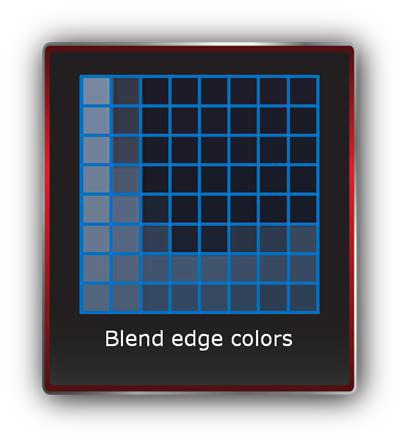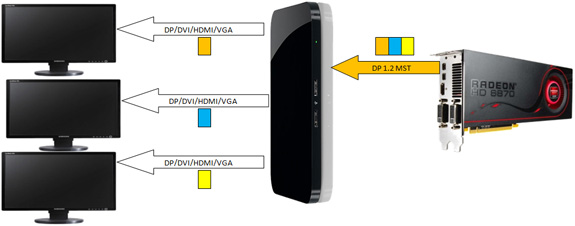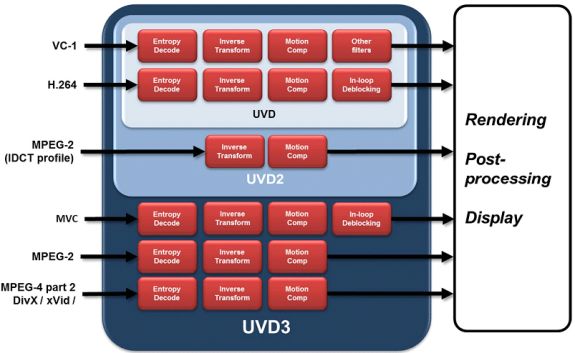AMD's Radeon HD 6970 & Radeon HD 6950: Paving The Future For AMD
by Ryan Smith on December 15, 2010 12:01 AM ESTRefresher: The 6800 Series’ New Features
Back in October AMD launched the first 6000 series cards, the Barts-based Radeon HD 6800 series. At their core they are a refreshed version of the Cypress GPU that we saw on the 5800 series, but AMD used the opportunity to make some enhancements over the standard Cypress. All of these enhancements apply throughout the 6000 series, so this includes the 6900 series. As such for those of you who didn’t pay much attention to the 6800 series, we’re going to quickly recap what’s new in order to lay the groundwork for further comparisons of the 6900 series to the 5800 series.
We’ll start with the core architecture. Compared to Cypress, Barts is nearly identical save 1 difference: the tessellator. For Barts AMD implemented what they call their 7th generation tessellator, which focused on delivering improved tessellation performance at lower tessellation factors that AMD felt were more important. Cayman takes this one step further and implements AMD’s 8th generation tessellator, which as the naming conventions implies is the 7th generation tessellator with even further enhancements (particularly those necessary for load balancing).
The second change we saw with Barts and the 6800 series was AMD’s refined texture filtering engine. AMD’s texture filtering engine from the 5800 set new standards by offering angle independent filtering, but it had an annoying quirk with highly regular/noisy textures where it didn’t do a good enough job blending together various mipmaps, resulting in visible transitions between them. For the 6800 series AMD fixed this, and it can now properly blend together noisy textures. At the same time in a controversial move AMD tweaked its default filtering optimizations for the 5800 series and entire 6000 series, leading to these cards producing imagines subtly different (and depending on who you ask, subtly worse) than they were on the 5800 series prior to the Catalyst 10.10 drivers.

| Radeon HD 5870 | Radeon HD 6870 | GeForce GTX 480 |
The third change we saw was the introduction of a new anti-aliasing mode, initially launched on the 6800 series and backported to the 5800 series shortly thereafter. Morphological Anti-Aliasing (MLAA) is a post-processing filter that works on any (and all) images, looking for high contrast edges (jaggies) and blending them to reduce the contrast. Implemented as a compute shader, it works with all games. As it’s a post-processing filter the results can vary – the filter has no knowledge of depth, polygons, or other attributes of the rendered world beyond the final image – so it’s prone to blending everything that looks like aliasing. On the plus side it’s cheap to use as it was originally designed for consoles with their limited resources, so by not consuming large amounts of memory & memory bandwidth like SSAA/MSAA it usually has a low performance hit.


Last but not least, AMD made a number of changes to their display hardware. The Universal Video Decoder (UVD) was upgraded to version 3, bringing full decode support for MPEG-2, MPEG-4 ASP, and H.264 MVC (packed frame video for 3D movies). For the 6900 series this is not of great importance as MPEG-2 and MPEG-4 ASP are low complexity codecs, but it does play an important role for AMD’s future APU products and low-end GPUs, where offloading these low complexity codecs is still going to be a big relief for the slower CPUs they’re paired with. And on that note the first public version of the DivX codec with support for UVD3 will be shipping today, letting 6800/6900 series owners finally take advantage of this functionality.
The second of the major display changes was the addition of support for the DisplayPort 1.2 standard. DP1.2 doubles DisplayPort’s bandwidth to 21.6Gbps, finally giving DisplayPort a significant bandwidth lead over dual-link DVI. With double the bandwidth it’s now possible to drive multiple monitors off of a single root DisplayPort, a technology called Multi Stream Transport (MST). AMD is heavily banking on this technology, as the additional bandwidth coupled with the fact that DisplayPort doesn’t require a clock source for each monitor/stream means AMD can drive up to 6 monitors off of a single card using only a pair of mini-DP ports. AMD is so cutting edge here that like the 6800 series the 6900 series is technically only DP1.2 ready – there won’t be any other devices available for compliance testing until 2011.

Finally, the 6800 series also introduced support for HDMI 1.4a and support for color correction in linear space. HDMI 1.4a support is fairly straightforward: the 6000 series can drive 3D televisions in either the 1080p24 or 720p60 3D modes. Meanwhile support for color correction in linear space allows AMD to offer accurate color correction for wide gamut monitors; previously there was a loss of accuracy as color correction had to be applied in the gamma color space, which is only meant for use for display purposes. This is particularly important for integrating wide gamut monitors in to traditional gamut workflows, as sRGB is misinterpreted on a wide gamut monitor without color correction.
While all of these features were introduced on the 6800 series, they’re fundamental parts of the entire 6000 series, meaning they’re part of the 6900 series too. This provides us with a baseline set of improvements over AMD’s 5800 series, on top of the additional improvements Cayman and AMD’s VLIW4 architecture brings.











168 Comments
View All Comments
DoktorSleepless - Wednesday, December 15, 2010 - link
What benchmark or game is used to measure noise?Hrel - Wednesday, December 15, 2010 - link
I'm not 100% but I believe they test it under Crysis. It was either that or a benchmark that put full load on the system. It was in an article in last year or 2, I've been reading so long it's all starting to mesh together; chronologically. But suffice it to say it stresses the system.Hrel - Wednesday, December 15, 2010 - link
It's furmark, it's in the article.Adul - Wednesday, December 15, 2010 - link
nice Christmas gift from the GF :DAstroGuardian - Wednesday, December 15, 2010 - link
I saw my GF buying a couple of those. One is supposed to be for me and she doesn't play games...... WTF?MeanBruce - Wednesday, December 15, 2010 - link
Wow, you are getting a couple of 6950s? All I am getting from my 22yo gf is a couple of size F yammos lying on a long narrow torso, and a single ASUS 6850. Don't know which I like better, hmmmmm. Wednesday morning comic relief.Adul - Wednesday, December 15, 2010 - link
damn sounds good to me :) enjoy both ;)SirGCal - Wednesday, December 15, 2010 - link
I'm happy to see these power values! I did expect a bit more performance but once I get one, I'll benchmark it myself. By then the drivers will likely have changed the situation. Now to get Santa my wish list... :-) If it was only that easy...mac2j - Wednesday, December 15, 2010 - link
One of the most impressive elements here is that you can get 2x6950 for ~$100 more than a single 580. That's some incredible performance for $600 which is not unheard of as the price point for a top single-slot card.Second... the scaling of the 6950 combined with the somwhat lower power consumption relative to the 570 bodes well for AMD with the 6990. My guess is they can deliver a top performing dual-GPU card with under a 425-watt TDP .... the 570 is a great single chip performer but getting it into a dual-gpu card under 450-500w is going to be a real challenge.
Anyway exciting stuff all-around - there will be a lot of heavy-hitting GPU options available for really very fair prices....
StormyParis - Wednesday, December 15, 2010 - link
It's nice to have all current cards listed, and helps determine which one to buy. My question, and the one people ask me, is rather "is it worth upgrading now". Which depends on a lot of things (CPU, RAM...), but, above all, on comparative perf between current cards and cards 1-2-3 generations out. I currently use a 4850. How much faster would a 6850 or 6950 be ?